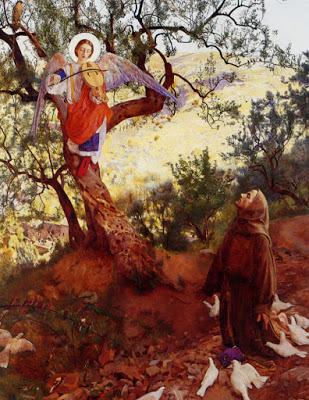
Saint Francis of Assisi and the Heavenly Melody
Often called 'the last Pre-Raphaelite', Cowper lived into the second half of the 20th century to the point that his art is still in UK copyright. You will certainly be familiar with many of the images that I will be using in the post because his work is often featured in discussion about the Pre-Raphaelites which is incredible if you think he was still alive at the centenary of the formation of the Brotherhood. So who was Frank Cadogan Cowper?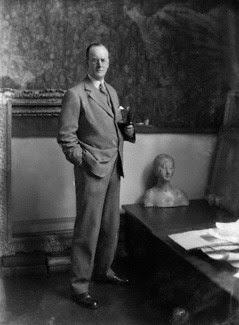
Frank Cadogan Cowper (1932) Bassano Ltd
Frank Cadogan Cowper was born 16 October 1877 in Wicken, Northamptonshire, where his maternal grandfather, Edward Cadogan, was the rector. His father, Frank Cowper, was the author of sailing books, both fact and fiction, and seemed to be away from home a fair amount, possibly in a boat (yet still managed to have six children) and doesn't appear on many census records after getting married. Recorded as the 'head' of the household in the 1891 census onwards was Edith Eliza Cowper, mother to Frank and a novelist in her own right...
Sailing Tours by Frank Cowper
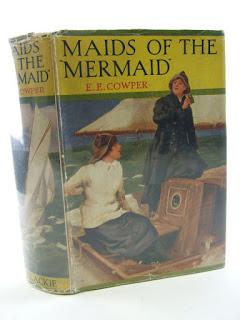
Edith Eliza (E E) Cowper, author of gripping stories for girls!
In one account of her early life it was stated that Frank Cadogan Cowper was raised Plymouth Brethren but I have not been able to find anything to back this up unfortunately. What is certain is that young Frank was born into a fairly affluent household, to which he was the eldest of the six children born over eleven years. He was sent to Cranleigh school, before heading for London and St John's Wood Art School followed by the school of the Royal Academy. He exhibited at the RA for the first time in 1899 but made it big in 1901 with this picture...
An Aristocrat Answering the Summons to Execution, Paris 1791 (1901)
Although I find Cowper's work fascinating generally, I think he does two things very well: pattern and dogs. The little dog in this picture is beautifully captured, but I adore the striped lining to the doomed aristo's coat. There is a certain amount of bloody-minded bravado in that fop's manner that could be applied to Cowper, and his insistence in not bending to fashion, as we will see.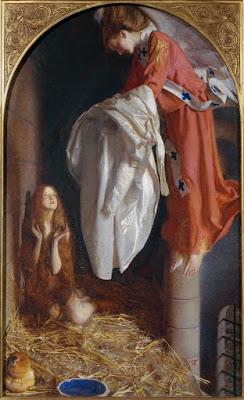
St Agnes in Prison Receiving from Heaven the 'Shining White Garment' (1905)

I also list Millais as an influence because of the dogs that appear in some of Cowper's paintings. I wonder if Cowper was a fan of Millais' Isabella because some of the smooth coated, elegant hounds that crop up in paintings such as Mariana in the South bring me straight back to Millais' dogs...
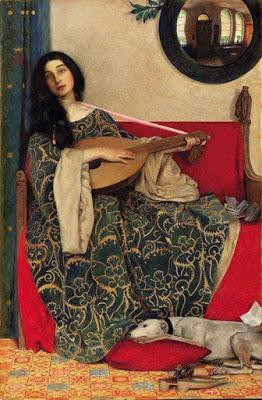
Mariana in the South (1906)
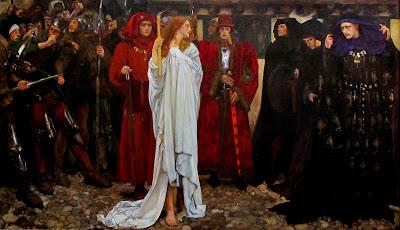
The Penance of Eleanor, Duchess of Gloucester (1900) Edwin Austin Abbey
Abbey believed that black, white and red were the colours of truly great artists and it is interesting to speculate on whether that influenced Cowper's color palate, but it is easy to see that whether or not Abbey played a great part in shaping Cowper's artistic vision, the two had a great deal in common with their subjects and style. However, even Abbey can't compete with the overblown bonkersness of something like Cowper's 1907 epic How the Devil, Disguised as a Vagrant Troupadour, Having been Entertained by some Charitable Nuns, Sang to them a Song of Love...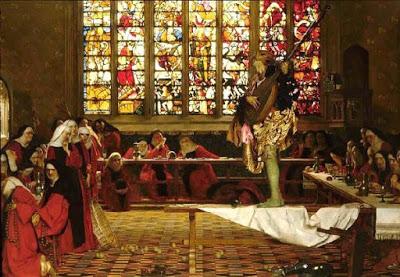
How the Devil... (1907)
The stained glass windows in the background are from Fairford church and the picture is a reworking of a student picture of a Minstrel that Cowper showed at a St John's Wood Art School show. An early sketch of the picture was so praised by the painter Onslow Ford that Cowper spent the next 15 years working it into a painting that demands even greater attention. Although he had been elected to Associateship of the Royal Water Colour Society in 1904, his election to ARA in 1907 was seen as a response to just how popular this picture was. It was reported in the newspapers how crowds would stand before it in Gallery IV of the exhibition and it was very nearly the Chantry purchase of the year. It was bought by Sir Joseph Beecham and sold on his death for 1,450 guineas (compared to The Beguiling of Merlin by Burne-Jones sold at the same sale for 2,600 guineas).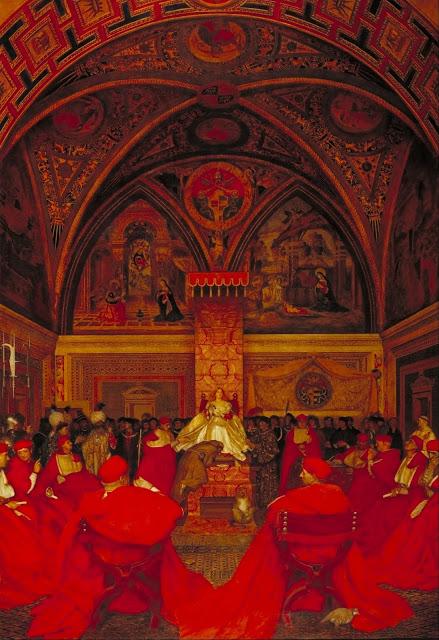
Lucretia Borgia Reigns in the Vatican in the Absence of Pope Alexander VI (1908-14)
Cowper finally got his Chantry purchase in 1914, with a picture that was described in the press as an 'Academy Sensation'. He traveled to the Vatican to paint the room from life and copy the faces of the cardinals from portraits. The scene depicts a friar kissing Lucretia's shoe while two noblemen hold back her dress. There's a monkey, some sort of pheasant and so much red that it makes your eyes hurt.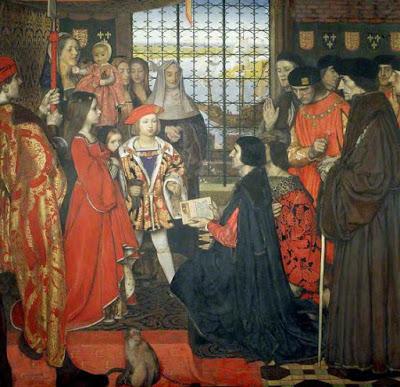
Erasmus and Thomas More Visit the Children of Henry VII at Greenwich (1910)
In 1910, Cowper took part in the mural scheme for the Houses of Parliament, along with other Pre-Raphaelite-ish Edwardians such as Byam Shaw. The little boy striking a manly pose in white tights is Henry VIII. The patterning of the clothing seems to be a repeated motif for Cowper and a rather easy way for the viewer to spot one of his works...
Four Queens Find Lancelot Sleeping (skirt!)
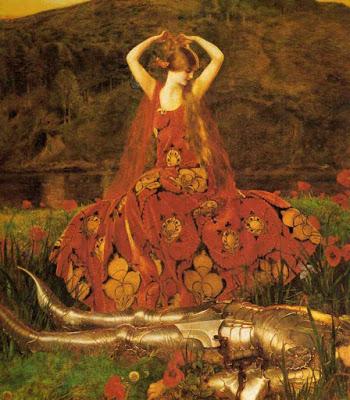
La Belle Dame Sans Merci (1926) (entire frock!)

Rapunzel (1900) (massive sleeve!)

Vanity (1919) (everything really!)
Also, he revisits subjects and titles, such as Vanity which he painted in both 1919 and in 1907...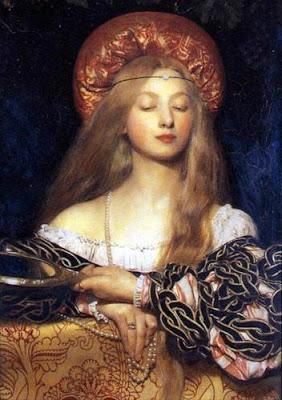
Vanity (1907)
He also reused not only bold patterns, but memorable garments, such as this 'knotted' dress, possibly a reference to Burne-Jones' Sidonia Von Bork 1560 (and/or joint source material Portrait of a Woman (1531) by Giuilio Romano, possibly also used for the film Sleepy Hollow), which crops up again in Venetian Ladies Listening to the Serenade...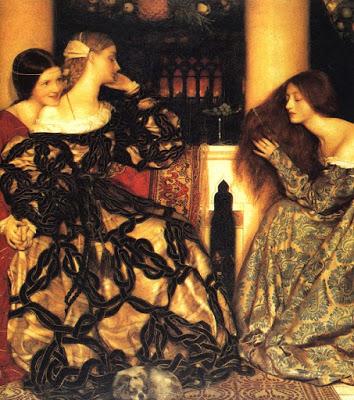
Venetian Ladies Listening to the Serenade
His adherence to Pre-Raphaelite sentiment and practices remained and can be seen in paintings such as Hamlet where he insisted on having a grave dug much to the alarm of his neighbours, in order to paint from nature. In other paintings he seems to have lifted details from the Brotherhood and made them his own, such as the dove in Beata Beatrix becomes The Blue Bird and Millais' sheep from Christ in the House of his Parents peek over the hurdles behind Our Lady of the Fruits of the Earth.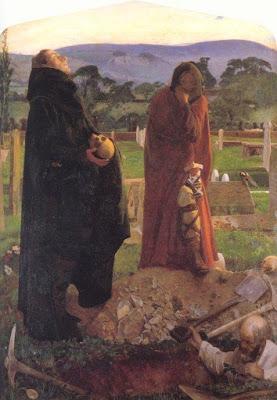
Hamlet, the Churchyard Scene (1902)
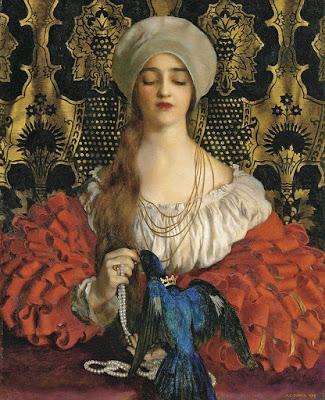
The Blue Bird (1918)
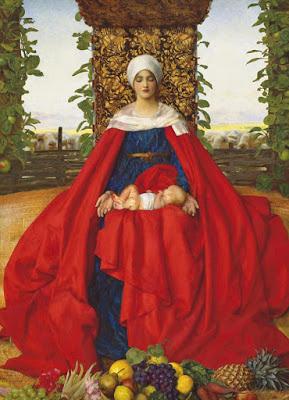
Our Lady of the Fruits of the Earth (1917)
With the fall of fashion for Pre-Raphaelite pictures, Cowper became known as a portrait painter. In his obituary in The Times they were judged as being 'confused' and the writer admitted 'it is difficult to speak with enthusiasm', even though his ability to paint was never in doubt. Despite becoming an RA in 1934 on the death of George Spencer Watson he was reported as a portrait painter and not a fashionable one at that. The parade of debs in pink that filled a great part of his output from 1920 onwards are the stuff of greetings cards and are charming but certainly seem to lack the fire and color palate of his previous works. In one rather harsh review of the RA exhibition in 1929 they were described as 'Cadogan Cowper's simpering ladies'...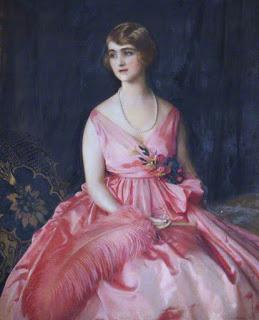
Violet Miriam Clay, Lady Vernon (1920)
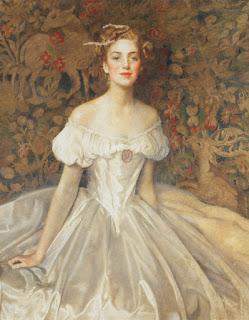
Elizabeth Witts (1954)
Occasionally he goes full-Rossetti and a massively patterned background takes over, which I think is why his obituary described his aims in these pictures as sometimes 'confused'...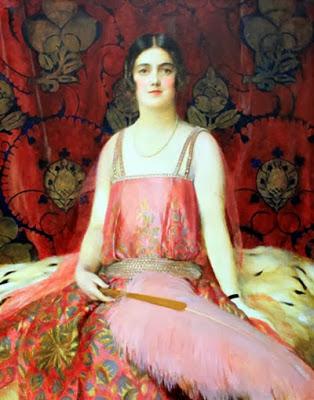
Portrait of Lady Ledgard (1925)
Let's be honest, she just got in the way of him painting massive, stylised poppies.Still, among these faintly awful portraits of posh flappers and post-war debs are still some canvases which defy explanation. One of these, and possibly my husband's least favorite picture (because it gives him the creeps) is this gem from 1940...
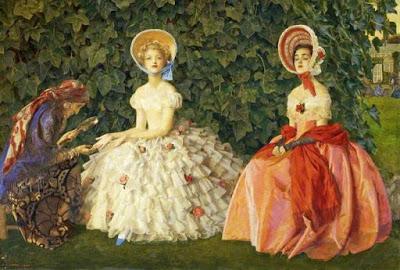
The Fortune Teller, 'Beware of a Dark Lady' (1940)
From the mutant ivy to the alarming fashion this is a giant 'what-were-you-thinking?' of a picture. When it was given to the Russell-Cotes in 1950, the museum confidently proclaimed that it would likely 'prove one of the most popular in our permanent collection' and that it was proclaimed picture of the year at the RA in 1940. Well, there was a war on. For all it's faults, it is a humorous picture with our happy blonde heroine not noticing how shifty her friend is. Again, note the use of bold fabric is brought in on the gypsy's skirt. I am campaigning at home to have this one back out on display as something as mad as this deserves to be seen again and I'll keep you informed of my progress...Anyway, Cowper's twilight years were marked for me by one very special painting which had been a favorite of mine for a while before I realised it was by Cowper...
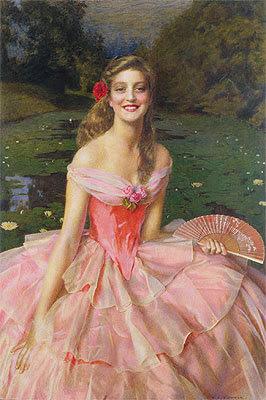
The Ugly Ducking (1950)
By 1950, Cowper had moved to live in the Cotswolds, possibly because of the time he had spent with Abbey almost half a century beforehand. He spotted a beautiful young woman behind the make-up counter in Boots and asked to paint her. The Ugly Duckling was the result and what lifts it for me is the cheery smile of the sitter and the humor of the title. I was delighted to read that the sitter, Valerie Tarantolo, now in her seventies and still very glam, had been reunited with her portrait at Cheltenham Art Gallery, where it is a much-loved painting (you can read her story here).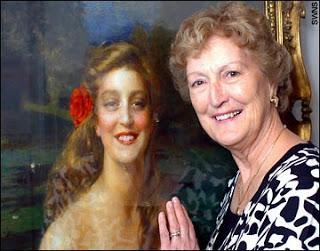
Valerie (at 16) and Valerie (a few years later)
Cowper died 17 November 1958 at his home in Cirencester and is buried at the Chesterton Cemetery in the town. On his gravestone is carved 'Verily, Verily I say unto you, He that believeth on me hath everlasting life' (from John 6:47). He might not be the first painter you think of, and his out-of-time Pre-Raphaelite blasts are often overwhelming and a tad peculiar, but one thing is for sure, enough of his work is so memorable that he is unlikely to be forgotten.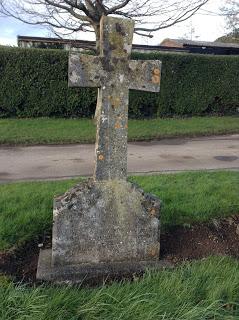
Frank Cadogan Cowper's grave in section 24 of Chesterton Cemetery
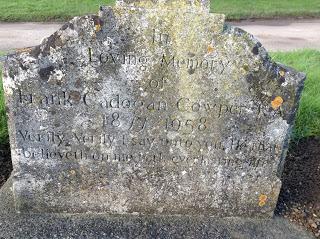
Detail of stone
The reason this post is called 'The Man in High Collars' is from his obituary which read 'There was little of the traditional artist in Cowper's appearance, and he is said to have worn the highest collars than any other man in the country'. Well, there you go then....
